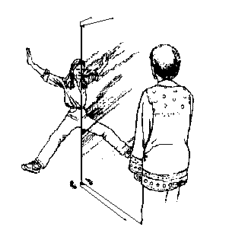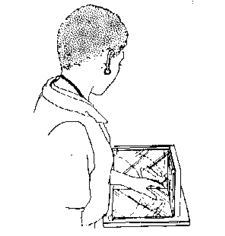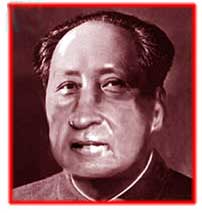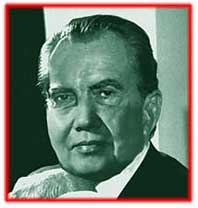|
|
|

|
|

|
|
KEY:
|
|

|
|
Can't find an exhibit
or have a question? Ask an explainer
|
|
|
|

|
Refers
to the exhibit graphics and the instructions in
them
|
|

|
Refers
to things to do not suggested in the instructions
on the exhibit
|
|
This
little tour around the museum asks you to look at
yourself a lot, so don't worry about your friends
thinking you're vain. (Even if you are!) Although we are
used to having mirrors around, they are actually pretty
strange things when you think about it. What was it like
in the long span of human history before mirrors? (Well
sure, one could always have looked into a still pool of
water, but you can't find those all the time! And
polished metals or glass are relatively recent
inventions.) Can you imagine not knowing what you looked
like? If you were having a bad hair day, you'd have to
ask someone to find out. Here's another question: If we
couldn't see ourselves, how much would we care what we
looked like? The funny thing is most mirrors don't
really show you how you look to other
people…
|
|
 
Associated
Snack
Cross-Reference
Entry
This
exhibit takes advantage of our body's symmetry to show a
powerful illusion.

- Why
is this exhibit called the Anti-Gravity Mirror?
Because
you can see yourself appear to float in the
air.
- How
do you make yourself into a three-eyed, two-nosed
monster?
By
positioning your head so that the edge of the mirror
bisects your left eye.

- Pretend
that your image in the mirror is actually another person
who looks a lot like you.
Put your hand over your left ear. What ear is the person
in the mirror covering?
Their
right ear.
|
|

Associated Snack
This
mirror reflects differently, depending on how you look at
it.

- With
the mirror horizontal, what happens to your image as you
move from very close to further away?
Your
image goes from being similar to a flat mirror reflection
to right-left reversed.
- When
you're further away, put your hand over your left ear.
Notice anything different between this reflection and the
one in a flat mirror?
Yes,
its left-right reversed.
- What
do you think might be the reason for this?
The
curved mirror allows the light rays to cross (see image
below).
- Which
image of you do you like better?
The
closer one, no, the further one....

- Try
staring into the mirror as you slowly turn it around. How
does this make you feel?
How
light reflects in flat and cylindrical
mirrors: 
|
|
 
Associated
Snack
Cross-Reference
Entry
This
exhibit is fun to do with a few friends. Suddenly you have
many friends!

- How
do you feel when you're in the kaleidoscope?
Possible
answers: "weird," "crowded," "cloned" etc.
- How
many of your images can you count? (Don't go crazy,
though!)
Definitely
more than 12!
- Besides
size, what's different about the images further away?
They
are less distinct, fuzzy around the
edges.
Can you guess why?
After
many reflections, the light has a greater distance in
which to spread out.
|
|
 
Associated
Snack
Cross-Reference
Entry
Look
at a reflection of a reflection of a reflection.

- Which
is your dominant eye?
- Put
your hand over your left ear. Which ear is the
upside-down you in the mirror covering?
Their
right ear.
Which ear is the right-side-up you covering?
Their
left ear.

- Here's
a thought experiment: Where does a rubber ball go if you
throw it straight into a corner?
More
or less straight back at you. Try it!
|

This
exhibit gives you facial expressions you never thought you
had!


- What
are the most distorted "surgeries?"
Some
are #2, #8, #10, #12, #14, #15, #18, #21
- Try
making some faces (happy, sad, angry, etc.) when you
freeze your face, then see if a friend can recognize what
kind of face you made from seeing it post-surgery.
- With
a friend, squish your faces together so you can line up
one eye each with the eyeholes on the screen. What
happens?
You
get very strange looking "post-surgery"
images.
|
|

This
one is kind of like Elastic Surgery, but you can put all the
different projections on the screen at once. Imagine that
your face is a map of the world.

- Pick
3 projections and state how (if they were a map of the
world) they might change your image of the world.
If
your face is the orange peel, what is the orange?
Your
skull would be the orange.
|
|

What
does it mean to be able to "discern" something?

There
are no instructions on this exhibit - so just experiment!
Press "Reset," and then try pressing different buttons,
one at a time. Notice how each time you hit a key
with arrows on it, your face gets more or less recognizable.
This quality, digitally speaking, is called
"resolution."
Make your image as fragmented as it can be.
- How
many hits of the increase-resolution key (the one with
four arrows pointing inward) do you need to recognize
yourself?
At
least 17.
- How
about for a friend to recognize you? A random museum
visitor? (ask an Explainer!)
- What
do you think the numbers 2, 4, 6 and 8 on the numbered
buttons mean?
They
correspond to the number of different shades between
black and white used to make an image of your
face.
|
|
These images are only on
the teacher pages! This is extra material!
What
distinguishes us? What clues or features do you rely on the
most in order to recognize someone?
Who
are these men?


Can
you guess? Check out the next set of images…


What
has been done to the above photographs? Which part of their
face do you think helped distinguish them the most?
Mao
and Nixon had the lower part of their faces switched. Their
hair, hairline, and eyes seem to help us distinguish them
the most.
This
activity is only this page, don't look for it, just do
it!
(if you're going to rob a bank, wear a wig)

What's
going on here?
All
of the boys pictured have the same face! But they look
different because they all have different hair.
|
|

Associated
Snack
Cross-Reference
Entry
Try
this exhibit with someone who looks nothing like you. You
might have more in common than you think!

- What
happens?
You
can combine your face with the face of a person sitting
across from you.
- Do
you think any of your facial features remain prominent?
Which ones? How about your partner's?
Up
to person viewing.
- What
do you think is your most distinguishing feature?
Up
to person viewing.
- What
happens when you do the last experiment (both lights
bright, blue buttons pressed)?
Half
of each person's face is blended together to form one
image.
|
|

Cross-Reference
Entry
You
can make a jigsaw puzzle of your face.

Move
your heads up and down to change the face in the glass.
- Does
the image in the glass look more like you, or more like
your friend?
- Which
of your features are visible when you think the image
looks more like you?
- Which
of your friend's features are visible when you think the
image looks more like him/her
|
|

Now
that you're so familiar with your own youthful face, try to
imagine what it might look like when you're 80 years old!

Experiment
with the exhibit.
- What
does it do to time?
It appears to make time speed up or slow
down.

- Go
to level 8, "Events that occur over decades." Check out
the woman aging. Strange, isn't it?
- In
your lifetime so far, have you noticed people grow older?
What was most noticeable about it?
- Why
might it be important to recognize people as older?
To
be able to find knowledge? Wisdom? To know that a person
might need help or
protection?
- How
have you noticed aging in other animals, such as
pets?
- Describe
3 other events that occur in a human lifespan. (You can
use the exhibit for this one.)
Similar
to the lifespan of an elephant; Saturn goes around the
sun almost three times; etc.
- Does
an 80-year lifespan seem long or short to you? Why?
- What
events might happen that you wouldn't want to miss? Check
out the plants growing or rotting in level 5.
- Have
you noticed these events before?
- Name
3 natural events that you have noticed over a period of
weeks.
- Name
3 natural events that you have noticed over a period of
months?
|


